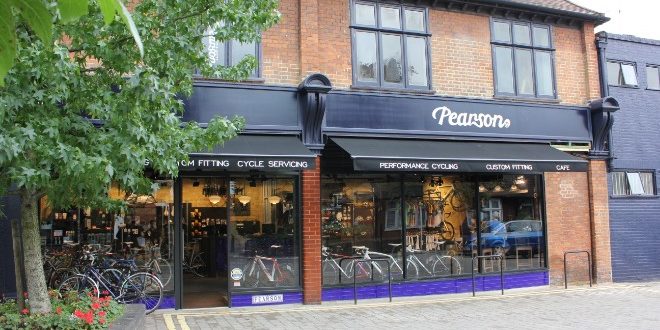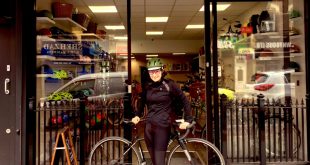Pearson Cycles will celebrate an incredible 160th anniversary next year. Rebecca Morley caught up with co-owner and director William Pearson to find out more about the world’s oldest bike shop
Can you give us a little background on the shop and your sustainable clothing range?
We now have two shops – the second opened in 2011. The Sutton shop is the original and it goes back to 1860. We’re almost 160 years old, that site is the oldest bike shop in the world according to the Guinness Book of World Records.
Myself and [co-owner] Guy are the fifth generation to take on the shop, and we’ve been here ourselves for around 20 years.
But our next bit of the business – which is a real focus for driving our online and brand business – is to launch our own sustainable clothing range.
Guy and I felt we had a real responsibility to make it sustainable. There’s so much waste and pollution created from clothing, and it was also a real opportunity to be able to start championing that side of things, where the bigger brands are probably so big that they can’t really turn that tanker very quickly.
We’re not quite 100% sustainable as some components are very difficult to find {in a sustainable way}.
We have three areas: road, adventure and urban. Those are the main specialist categories that we tend to have in-store. The market we have generally revolves around that.
But it all ties together – the bikes we have are designed so that they prop up those three categories. We’ve got a road range, an adventure range and an urban range.
If you’ve got a road bike, then you’ll need bib tights, bib shorts and certain jackets, and the same applies to the adventure and urban.
Ultimately it’s about us having a very boutique category of bikes, clothing and accessories that all fit together in a very easy-to-understand bundle.
What made you decide to launch your own brand?
Pearson has always had its own brand of clothing. It’s been sourced through typical Italian factories, and although it’s good quality, they weren’t really touching on the sustainability element.
We quickly realised that it had to be done off our own backs; that we had to specifically search for the right fabrics and designs to make it both sustainable and ideal for our customers throughout multiple categories.
Stocking lots of third-party brands, certainly within store, wasn’t really building much value beyond just selling someone else’s brand, which, as many shops will know, is often just cheaper to buy on the internet.
Potential customers would come in, try something on, get the size, and then disappear and find a cheaper price online.
Being able to offer something unique and own-brand built value into the business, and with the online side of things, we had a lot of opportunity to be able to sell abroad as a British heritage-style brand.
Going back to the stores, what’s the secret to your success and longevity?
Ultimately I think it’s having exemplary customer service all the way. It may sound obvious, but the customer always comes first, and that goes a long way. You have to make sure every customer who comes into the store leaves wanting to ride their bike more, even if they haven’t necessarily bought anything.
Our main objective is to make the world want to cycle. We’re very keen to maintain that, and we do it through well-educated, experienced staff, but whom also have empathy for people who may not know as much about cycling, and aren’t worried about asking certain questions.
Cycle shops can be quite daunting places. Unfortunately, I think this is doubly true for women, where the look and the feel of the store can often be quite intimidating.
What are your plans moving forward?
We may consider more shops. I think they’d be on a more boutique basis – we’ve seen that a lot of brands, the bigger brands, have been side-stepped a little bit by new kids on the block. For example, Canyon has come in and gone direct to consumer, and where you’ve got the major American brands like Trek and Specialized, they’ve been left lagging a little bit, although I think they’re doing generally okay.
It’s just how long that traditional model of selling bikes through dealerships is going to last, and how long it might be until they are going direct to consumer, or a format of it.
From that perspective, we wonder what the future of big bike shops are. What will finally happen is that big brands will eventually just cut out the middle man, and either go direct to consumer online or start bringing out their own stores.
We ally with Trek, Specialized and Brompton in-store, but online we are purely Pearson.
I think it makes more sense. Rather than having everybody else’s brands online, you end up in that position where you’re competing against the lowest common denominator of who’s going to sell them the cheapest.
From a more sustainable future, we feel that the own-brand route is a sensible way to go and we feel we’ve got a good name and reputation to back that up.
How do you think the market for IBDs has changed in recent years?
I think there’s been a move towards more service-orientated businesses, shops with more servicing going on and I think the figures show that a lot of the workshop activity is increasing and bike volume is generally dropping.
E-bike sales are definitely on-trend, plus we are selling a greater number of higher-end bikes and fewer numbers of entry-level bikes.
I think servicing is really a major part, as people go online and rely less on dealers to sell them bikes and parts.
I think much more service-orientated independents will do well. Those that are hanging onto a more traditional model of bike retail are likely to be the ones that will suffer more.
I don’t think I’ve seen retail change as quickly as it has done in the last five years.
Online as we all know has taken the world by storm. The ease of buying through virtually every digital channel that touches you is hard to ignore. You are being sold to from every angle!
We are certainly here for the long term and a lot of our beliefs are in legacy and sustainability for the next generation.
 BikeBiz Bicycle and cycling retail news
BikeBiz Bicycle and cycling retail news




